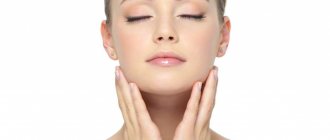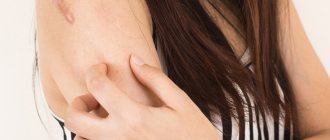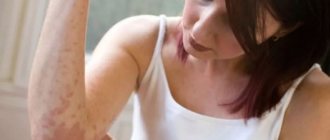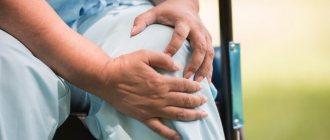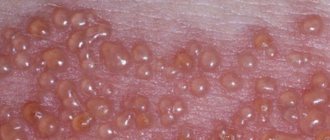Ringworm is a dermatological infectious disease with similar symptoms that is caused by viruses or fungi.
They are classified depending on the pathogen, location and degree of damage to the skin. According to WHO statistics, more than 70% of children are affected by this skin disease, both in newborns and older.
The group of lichens includes:
- lichen Zhibera or pink lichen;
- ringworm (the most common form);
- shingles;
- lichen planus or Wilson's lichen;
- ringworm or eczema;
- lichen simplex of the face;
- scaly lichen or psoriasis;
- pityriasis versicolor.
The mechanism of infection has not been reliably identified, since not every child who comes into contact with a carrier of the pathology gets lichen.
There are a number of catalyst factors that increase the likelihood of developing the disease, including:
- genetic predisposition;
- diseases of the digestive tract;
- endocrinological dysfunctions;
- autoimmune pathologies;
- hyperfunction of the sweat and sebaceous glands;
- stress;
- physical stress;
- hypothermia of the body;
- taking certain medications, etc.
Late detection of a lichen spot often leads to an increasingly larger area of skin being affected, causing itching, peeling and discomfort. Often children scratch and injure the affected areas of the skin, which contributes to the addition of a bacterial infection to the underlying disease.
In order to identify and remove lichen from a child’s skin, you need to contact a specialist. A doctor whose competence is the diagnosis and treatment of lichen in children is a pediatric dermatologist.
In addition to treatment, prevention is important in eliminating and preventing relapse of the disease.
Preventive measures for the primary or recurrence of lichen are:
- strengthening the child’s immunity (hardening, etc.);
- compliance with hygiene standards (washing hands, cleaning premises with disinfectants, etc.);
- separate individual items (bed and personal linen, dishes, toys, etc.);
- frequent washing of the child’s clothes, especially after contact with animals or sick people;
- showering rather than bathing to avoid the spread of infection;
- replacing synthetic clothing with natural ones;
- reducing exposure to the sun (heat provokes the growth of fungal colonies), etc.
What is pityriasis rosea and why is it called pink dandruff?
The content of the article
Pink dandruff (Pityriasis rosea - PR) is an acute inflammatory disease of unknown etiology, characterized by the appearance of skin rashes mainly on the torso and limbs. It is an erythematous, scaly disease. The disease occurs seasonally. The etiology is most likely viral. The most likely factor is herpes virus type 7 (HHV7).
Most cases (75%) involve people aged 10 to 35 years, although there have been reports of cases diagnosed in a 3-month-old infant and in an 83-year-old man. The disease occurs throughout the world without any particular racial predilection.
Pityriasis rosea is a disease for which patients visit a dermatologist with a frequency of up to 2% of all visits per year. Occurs mainly in spring and autumn; in summer the level of symptoms decreases significantly.
The disease affects more women than men in a 2:1 ratio. The duration of the disease is 6 to 8 weeks, but is highly variable.
Description of the disease
Depending on the type of lichen, the rash may be dry or weeping, pale pink or bright red.
Most often, the disease affects the back, face and chest of the child (it is in these areas that the largest number of sweat glands are located). The disease is infectious in origin and is caused by viruses or fungi. The disease most often manifests itself in the spring-summer season, when it is warm and humid outside. At the moment, a large number of varieties of lichen are known. Many of them are highly contagious and potentially dangerous to the child’s immediate environment. That is why, if there is any suspicion of an infectious disease, it is necessary to immediately show the patient to a qualified specialist.
Many names - one face. Symptoms of pityriasis rosea
The first description of the disease as "ringed roseola" dates back to 1798. Uch. Robert William defined the disease as irregularly shaped spots consisting of small thin scales that never coalesce into scabs and are not accompanied by redness or signs of inflammation.
Other names for this disease: erythema annulatum, tonsurans maculosus, Herba, roseola squamosa (Nicolas, Chapard), pink lichen (Wilson), pityriasis versicolor (Horand), pseudoexanthemata nitoexanthemata, roseola furfuracea herpetiformis (Behrend) - mainly determined the morphological features and variability individual spots.
Pityriasis rosea
Only in 1860, the French physician Camille Melchior Gibert gave the name, which lasted almost 150 years. He wrote: “There is only one thing that can be described under the name of pityriasis rosea, and the characteristic features of this pathology are: small, branched spots, very faintly colored, no larger than a fingernail, numerous and tightly fitting ... the disease usually lasts up to 6 weeks or 2 months... in young people... ". Pityriasis means "bran" or "fine husk" and rosea translates to "pink".
The symptoms of pink dandruff are indeed quite characteristic. First, a heraldic lesion (the so-called mother plate) appears on the skin, most often on the torso. Usually it is several centimeters of red or dark pink erythema, covered with scales inside.
After a few days (and sometimes weeks), much smaller skin lesions of similar morphology are seeded. The rash occurs symmetrically, mainly on the torso and neck. There are no changes in the mucous membrane. Usually the skin lesions do not cause itching.
Possible variations of the rash:
- urticarial form of RL – blisters appear instead of plaques;
- vesicular form of RP - rashes in the form of small bubbles with clear or cloudy liquids;
- papular form of RL – protruding, cavity-free formations.
Why is lichen dangerous in children?
The greatest danger for children are the following consequences of deprivation:
- addition of a bacterial infection;
- spread of pathology to internal organs (bones, brain, etc.);
- development of immunodeficiency.
However, the degree and nature of complications after the disease depend on the type of lichen. Thus, pityriasis rosea occurs without side effects and does not cause deterioration in the child’s health. Trichophytosis leads to the formation of bald patches, and pityriasis versicolor, ringworm and red lichen cause a secondary infection, which significantly complicates treatment.
Herpes zoster can cause postherpetic neuralgia, as well as:
- impaired motor activity of the arms and legs;
- reduction and partial loss of sensitivity of the limbs;
- inflammatory process in the structures of the eye (eyeball, cornea, etc.);
- inflammation of the tissues of internal organs (liver, membranes of the spinal cord and brain, etc.).
Reasons for the development of pink lichen of Zhiber
Although the disease has been known for a long time, its pathogenesis still remains unclear. Various factors and pathogens have been proposed as causes:
- infectious;
- viral;
- bacterial;
- fungal;
- Mycoplasma pneumoniae;
- “toxic rash due to unknown gastrointestinal infection”;
- insect bites;
- isomorphic response;
- autoimmune disease;
- psychogenic cause.
Insect bite
Early research suggested a connection to new, unused clothing. Lassar and Rosenthal attributed this role to flannel and knitwear.
The development of a peculiar skin plaque was observed at the site of insect bites, especially fleas, as well as on old scars, with healing gunshot wounds, and at the site of intramuscular injections, which suggests that pink dandruff is simply an isomorphic reaction.
Some scientists have tried to show that pityriasis rosea is a psychogenic disease and is more common in "highly stressed" or mentally ill people. According to them, stress can aggravate the lesion and cause itching. Others consider the psychosomatic theory unlikely.
Attempts have also been made to hypothesize that RP is a “toxic rash of gastrointestinal infection,” the result of dietary error and gastric dilatation.
In 1970, Birch and Rowell postulated an autoimmune cause of the disease, in which the predisposition was genetically determined and sensitized by microorganisms.
However, the infectious background of the disease is most widely considered. Clinical features of the pathology, such as the irregular occurrence of prodromal symptoms and the severity of morbidity in the autumn-spring period, indicate a viral etiology. There appears to be an association with a recent upper respiratory tract infection in some patients.
The spread of the disease in the family, among children at school, among soldiers in the barracks, among people using Turkish baths has not been confirmed, so many experts believe that it is a non-infectious disease.
However, pityriasis rosea has been found to be more common among dermatologists than among otolaryngologists, suggesting that it is spread through contact with low infectivity, leading to increased incidence with increasing number of contacts.
In addition, the pathology is more common in people with weakened immune systems, for example, pregnant women and patients with bone marrow transplantation. Spontaneous resolution and relapses, occurring in less than 3% of patients, are also consistent with the theory of a viral origin of the disease.
There is some objective evidence to support the viral theory of the disease. In 1968, scientists demonstrated the presence of picornavirus-like intranuclear bodies in the tissues of African green monkeys inoculated with a liquid that affected the color of the lesions, and in electronic sections of these lesions. However, none of the studies have identified the genome of picornaviruses. Pityriasis rosea has also been described in a patient with proven Echo virus infection.
The HHS-7 virus, a Roseola virus from betaherpesviruses, is also suspected. Viruses of this family cause acute and chronic infections. They can also remain latent for many years, and a weakened immune system leads to their activation. HHS viruses have been detected in children with RP and adults with pink dandruff in serum, white blood cells, and biopsies of skin lesions.
However, the relationship between pityriasis rosea and HHS-7 remains controversial according to some scientists, due to the low DNA sequence index of HHS-7. The virus has also been detected in the plasma of healthy people.
It has been suggested that the disease is associated with bacterial infection, including syphilis and tuberculosis. In 1942, student. Benedek explained the occurrence of the disease by the reactivation of latent foci of Baccillus endoparasiticus.
The role of Staphylococcus albus and hemolytic streptococci was also increased. In recent years, infections with Legionella micadadei, L. longbeachae, L. pneumophila, Chlamydia pneumonie, Ch. trachomatis, but the opinions of dermatologists about their role in the pathogenesis of RP are divided. Thus, the issue of the involvement of these microorganisms requires further research.
The clinical appearance of the mother's plate, with morphological features often resembling a lesion of mycosis, especially ringworm, suggests that the cause of pink dandruff may be a fungal infection.
Some medications also sometimes cause skin lesions similar to pityriasis rosea. Among them:
- captopril;
- metronidazole;
- isotretinoin;
- D-penicillamine;
- levamisole;
- diphtheria toxoid;
- bismuth;
- gold;
- barbiturates;
- ketotifen;
- clonidine;
- terbinafine;
- omeprazole
Pityriasis rosea has been reported following administration of BCG, IFN-alpha and hepatitis B vaccines.
Now scientists are inclined to conclude that such a reaction of the body can be caused by various factors, and this is very important to take into account when diagnosing pathology. By identifying the suspected cause, you can quickly and permanently get rid of unpleasant symptoms.
The most likely reasons are a weakened immune system and the activation of one of the types of herpes viruses against this background. Therefore, it is necessary to consider all causes that weaken the immune system.
Which doctor should I go to if my child has shingles?
As we have already mentioned, a doctor who diagnoses and treats dermatological diseases is a dermatologist. Since the structure and functioning of the skin of a small child is significantly different from the skin of an adult, it is the pediatric dermatologist who should make the diagnosis.
Features of children's skin that determine high sensitivity to external irritants and pathogens are:
- skin thickness (in an adult it is three times thicker);
- loose epidermis;
- lack of elastic fibers;
- weak ability to form skin pigments (low protective function);
- low degree of thermoregulation, etc.
Diseases of the skin and its appendages (hair and nails) can be a consequence of various pathological processes in the child’s body (systemic or autoimmune diseases, etc.), so additional consultation with a pediatric neurologist, immunologist, infectious disease specialist or other specialists may often be necessary.
Diagnosis of pityriasis rosea
The diagnosis can most likely be made based on the history and clinical picture. Differentiation should take into account, among other things:
- mycosis;
- psoriasis;
- seborrheic dermatitis;
- drug allergies;
- eczema;
- parapsoriasis.
Seborrheic dermatitis
These diseases produce similar symptoms, but require special treatment.
To make a diagnosis, you need to carry out a number of special tests, for example, scrapings of the affected areas, serological studies. Blood and urine tests are also prescribed to understand whether there is inflammation in the body and its consequences.
Some patients, after reading articles from the Internet and looking at pictures, make a diagnosis for themselves, refusing tests. The result of such behavior is often sad. As a result, they get advanced contagious lichen or another equally unpleasant disease.
What tests need to be taken for pityriasis rosea?
The diagnostic method and set of necessary studies are determined by a dermatologist. Typically, the patient takes a blood test to study general indicators. Tests are often ordered to detect antibodies to viral agents, including syphilis and herpes. To exclude fungal damage to the skin, microscopic examination of scrapings from the site of the lesion is carried out.
Additionally, the doctor may prescribe an immunogram if there is a suspicion of a significant decrease in the body's defenses. The cause of pityriasis rosea is an allergic reaction, so testing for allergens is possible. If necessary, the doctor prescribes additional examinations and consultations with specialists. Typically, such measures are taken in case of protracted or atypical course of the pathology.
Treatment of rosea lichen Zhibera - outdated and modern methods
The pathogenesis of pink dandruff remains in the realm of more or less probable speculation. Therefore, treatment of patients should be aimed at relieving symptoms and preventing possible complications.
Misunderstanding of the cause of the disease has led to various attempts at treatment in the past.
In 1922, Burchardt wrote in his textbook Diseases of the Skin: “Pityriasis rosea does not require intensive treatment... the use of strong drugs can sometimes make the situation worse, since they aggravate the inflammatory symptoms, unnecessarily irritate the skin and cause itching. In most cases, it is sufficient to recommend starch baths at 28 degrees 2 times a week and lubrication once a day with 10% zinc ointment with the addition of salicylic acid or 1-2% resorcinol, sulfur (1-3%), thiol or ichthyol (up to 5% )".
Uch. Roxburgh recommended 2% salicylic ointment at night to exfoliate the lesions in most cases, followed by exposure to ultraviolet light. Instead of ultraviolet light, it was recommended to use a 20-minute bath with the addition of potassium permanganate or sodium thiosulfate, and then apply salicylic ointment. Other authors write about the effectiveness of using 2% salicylic ointment twice a day.
2% salicylic ointment
Sutton recommended bathing in a 1% mercuric chloride solution. Opponents of treatment with sulfur and mercury preparations recommended lubricating the lesions with a paste that reduces itching. They emphasized the importance of frequent bathing. Marshall wrote that when itching predominates, it is useful to use a mixture of zinc oxide and lime water with the addition of 2% phenol.
They tried to dissolve the scales with an aqueous saline solution. A 2% eosin solution, a 6% alcoholic solution of bergamot oil, tar, olive oil and lime water in 0.25% menthol were used.
It is currently believed that active treatment of pityriasis rosea that is not accompanied by itching is not necessary. And in case of itching, it is recommended to rub it with weak corticosteroid drugs in the form of creams and lotions, selected by a dermatologist. The patient should be instructed not to use harsh soaps or wear tight clothing due to the potential for irritation.
Other external methods that have been used in extensive cases include radiation therapy. Some scientists recommended irradiating each side of the body in turn, suggesting that the most effective therapy was started at the beginning of the inflammation, and that after a week there should be some improvement. Others have written about superficial radiation therapy, which involves taking a single dose or a small portion of it.
There are scientists who recommended using a quartz lamp in difficult cases so as not to cause an erythematous reaction. Others have emphasized the role of ultraviolet light in clearing lesions more quickly, while pointing out the potential for discoloration of spots that persist for months. It is recommended to use erythematous-exfoliating doses - sometimes one such dose is enough.
More recent studies have included UVB radiation used daily for 5 days at doses that cause erythema. The treatment reduced itching and suppressed the development of lesions. The remaining authors started with 80% min. dose causing erythema, and increased it by 20% with each subsequent irradiation. Itching with this treatment may disappear even within 24 hours.
UV-B radiation
In general treatment of PR, attempts have been made to administer streptococcal vaccines, staphylococcal toxoid, fungal and yeast extracts, milk injections, salicylates, calcium bromate, calciferol, and potassium iodide. There are reports of very beneficial effects of a single injection of typhoid vaccine.
In 1940, academician Willes and Klumpp used convalescent plasma (5 cm intramuscular) and human gamma globulin to treat pityriasis rosea. The latter, administered in the first week of treatment, changed the course of the disease, while its administration later, like convalescent plasma, did not affect the outcome.
In 1948, student. Grzybowski argued that the correct treatment of pink dandruff is the administration of antistreptin in the amount of 4.0-5.0 g or cibazol in the amount of 6.0-8.0 g per day for 4-5 days, sodium bromide and autohemotherapy.
In the same year, Hallstrom reported the beneficial effects of bismuth and salvarsan, and 2 years later the Polish Medical Weekly reported rapid regression of lesions after intramuscular injection of 4-6 injections of 10% bismuth oil suspension every 2 days, 1 ml. every. The good effect of the therapy was so rapid that it was postulated that bismuth would become a specific treatment.
A successful attempt was made to administer streptomycin. Injections of penicillin in various doses: 300,000 units, 450,000 and 500,000 units did not bring the expected results. Supportive measures were taken including vitamin C (0.5 g/day) and vitamin B (20).
Another drug that has been used to treat PR is Encortone. Even without external treatment in small doses (5 mg), this turned out to be a fast and effective method. More recent studies have shown that steroids may need to be prescribed in general from time to time to control very generalized lesions. Prednisolone was used intramuscularly at a daily dose of 15-40 mg. For blisters that do not respond to general steroids, dapsone 100 mg twice daily is recommended for short-term treatment.
Recently there has been interest in erythromycin. Adults were prescribed 250 mg/day 4 times a day, children - 20-40 mg/kg/body weight, in 4 divided doses. Some experts claim that the effect of this method is comparable to placebo, while others argue that since it is impossible to specify the exact cause and the exact treatment, trials of erythromycin treatment that produce results are recommended and safe.
Oral antihistamines are now recommended in cases of itching. Rare oral symptoms can be relieved with toothpaste containing diphenhydramine hydrochloride or tetracycline hydrochloride.
Symptoms of pathology
Symptoms of ringworm appear 4-6 weeks after the patient becomes infected. A red spot appears on a smooth area of skin of a child or adult. It rises above the surface and has smooth boundaries. Over time, the size of the lesion increases. The surface becomes covered with nodules, blisters and scabs. The spots develop into rings that can intersect or merge with each other. The diameter of skin formations ranges from 5 to 30 millimeters.
Signs of ringworm include an acute inflammatory reaction. It often develops in children and girls. The lesions begin to peel off intensively. Patients suffering from dermatitis do not immediately identify symptoms of microsporia. Areas of active fungal growth may appear as inflammatory skin lesions.
A common manifestation of ringworm in a child is damage to the scalp. This symptom affects patients aged 5-12 years. Older children experience changes in the chemical composition of sebum. Its elements become dangerous for the microsporia pathogen.
The suppurative type of ringworm is characterized by the appearance of soft nodules on the patient’s skin. The nodes are dotted with numerous abscesses. When they are compressed, purulent contents are released.
Are you experiencing symptoms of ringworm?
Only a doctor can accurately diagnose the disease. Don't delay your consultation - call
Correct treatment of pink dandruff in Gibert's disease
Treatment of pityriasis rosea is primarily based on the diagnostic results and recommendations of the dermatologist based on his knowledge and experience. Independent attempts to cure pathology usually lead to the appearance of accompanying symptoms, sometimes very dangerous.
Considering the symptoms, the dermatologist prescribes:
- ointments with corticosteroids acting in several directions - relieve skin tightness and accelerate the healing of the rash;
- antiallergic - antihistamines - relieve itching;
- immunomodulators – stimulate natural immunity;
- antiseptic solutions – prevent secondary infection;
- dandruff softening ointments.
During treatment, the dermatologist recommends:
- Avoid hot water procedures and swimming. Showering with a soft sponge is allowed;
- Wear loose, natural underwear. Synthetics do not allow the skin to breathe, exacerbating symptoms;
- Eliminate allergens: eggs, chocolate, red fruits.
- Reduce fried, flour, smoked foods;
- Do not use cosmetics.
Preventive measures
Prevention of ringworm is based on regular medical examinations of children attending preschool educational institutions. Parents should talk to their children about the inadmissibility of contact with stray animals. An important preventive measure is compliance with personal hygiene rules by patients of all age groups.
When purchasing pets, you must visit a veterinarian. The doctor will examine the cat or dog and give recommendations on how to eliminate any health problems with the pet. Following your veterinarian's advice will help prevent microscopic outbreaks within your family.
How do you know if pityriasis rosea is going away?
After a course of therapy, the spots disappear without scarring. In place of the plaques, clean skin remains, possibly lighter. Over time, the color evens out. In patients with atypical lichen, ulcers may form.
Complications during self-medication:
- infection of affected areas with bacteria;
- suppuration, ulcers;
- hyperpigmentation.
Hyperpigmentation
To prevent this development of the disease, at the first symptoms of pityriasis rosea, it is recommended to make an appointment with a dermatologist.
Features of choosing children's ointments
If the choice of drugs that could be used to treat children were based only on effectiveness against pathogens, pharmacists could replace pediatricians. But each child’s body is unique, and therefore requires a specific approach. A medicine can help one person and cause a powerful allergic reaction in another. The doctor has to take into account the specific set of diseases of young patients, the development of internal organs, and the state of immunity.
Treatment of children often requires changing methods of therapy directly in the process of fighting lichen. Therefore, you should buy ointments only after consulting a pediatrician and undergoing diagnostic procedures.
Incorrect treatment of pityriasis rosea
- Lubrication with iodine, brilliant green
. These antiseptic drugs do not provide results in the treatment of pink dandruff. The virus is located deep in the skin, so iodine or brilliant green cannot affect it, but at the same time they dry out the skin, causing a burn. - Celandine
. The poisonous sap of the plant leads to damage and inflammation of the skin. Celandine causes burns, increasing the risk of complications. - Zinc ointment
. Causes skin tightness. - Salicylic acid, alcohol
. Ineffective against the virus. Dries and irritates the skin, increasing peeling. Leads to hyperpigmentation. - Vinegar
. Dries out the skin and increases peeling.
To treat Gibert's disease, you can only use products prescribed by a dermatologist.
Sources
- Anderson KR: Treatment with dapsone in pityriasis versicolor vesicularis rosea, 1971;
- Andrews GK: Skin Diseases 1954;
- AranjoT. et al.: Human Herpesviruses 6 and 7, 2002;
- Bernhardt R.: Skin diseases: 1922;
- Bjornberg A, Hellgren L: Pityriasis rosea. Statistical, clinical and laboratory research, 1962;
- Buckley K: Rash resembling pityriasis rosea in a patient receiving omeprazole, 1996;
- Gutowski W.: Attempt to treat Gibert's pink dandruff with bismuth and penicillin, 1950;
- Kempf W. et al.: Pityriasis rosea is not associated with human herpes virus, 1999;
- Parson JM et al: Update on pityriasis rosea, 1986;
- Sharma PK, Yadav TP: Erythromycin for pityriasis rosea, 2000;
- Wass I.: Treatment of pityriasis rosea with nonspecific substances, 1948.
ONLINE REGISTRATION at the DIANA clinic
You can sign up by calling the toll-free phone number 8-800-707-15-60 or filling out the contact form. In this case, we will contact you ourselves.
